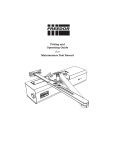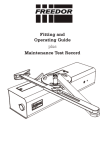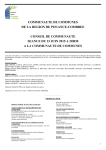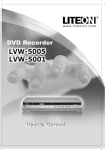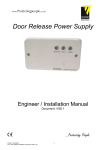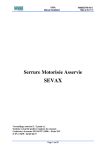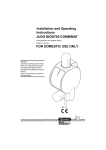Download Dorgard user guide DT:Dorgard X.qxd
Transcript
Fitting and Operating Guide plus Maintenance Test Record This is an important document detailing the correct installation, usage and maintenance of the Dorgard. This Guide must be read and fully understood before you start installation and be kept in a safe place such as your Fire Risk Assessment file. Keep this Guide in a safe place. Contents Introduction Page 2 Prior to Installation 3 Important Information 4 Batteries 5 Setting the Time 5 Night-time Release 6 Installation 7 Floorplate Installation 8 Dorgard Operation 9 Setting the Time 9 Testing Dorgard to the Fire Alarm 10 Sensitivity Adjustment 11 Trouble Shooting 12 Error Messages 14 Maintenance Schedule 16 Maintenance Record 17 Commissioning Certificate 18 Manufacturer’s Warranty 19 MANUFACTURED TO COMPLY WITH BS EN 1155:1997 The European Standard EN 1155:1997 has the status of a British Standard. Manufacturer’s Classification:As Required By BS EN 1155:1997 ID of Certification Body:- 1121 Registered Address:- Fireco Ltd., 30 New Road, BRIGHTON BN1 1BN, UK CE mark applied for:- 08 EC Certificate of Conformity Number:- AE0021 Power size:- Minimum 3 to Maximum 7 3 5 3 to 7 1 1 1 0 Introduction Dorgard is a Battery Operated device designed to hold open a fire door safely and legally. Dorgard will automatically release upon “hearing” the fire alarm. Dorgard can be used to hold the fire door in any position between open or closed. It is recommended that a fire door is not retained at an angle of less than 65 degrees. 2 Prior to Installation Prior to installation ensure: 1. That a suitable Automatic Fire Detection Alarm System is installed. 2. The fire door is self-closing i.e. has a door closer fitted. 3. The fire door closes tightly against the door jamb. 4. Where Dorgard is to be fitted, the floor and door surface is smooth and flat. 5. You have determined the closing force of the door. 6. The Fire Alarm System is working correctly, i.e. the sounders work when activated. 7. There is clearance under the fire door for fitting of the Floorplate, i.e. 5mm. 8. Dorgard forms part of your Fire Risk Assessment (as required by the Fire Precautions [Workplace] Regulations 1997, also required by the Regulatory Reform (Fire Safety) Order 2006). When Dorgard is holding a fire door open, the Dorgard “listens” continually for the sound of your fire alarm. When the alarm sounds, Dorgard will verify the alarm over a 20 second period and then release the fire door. 3 Important Information Dorgard must only be used for the purpose for which it is designed. Dorgard is not suitable for external use. Read this Guide and follow the instructions carefully, keeping it in a safe place e.g. in your Fire Risk Assessment file, for future reference. BS EN1155:1997 states that a door must not be retained at an open angle of less than 65 degrees. It is recommended that the Floorplate be installed to comply to this standard. Dorgard, when installed correctly, complies with BS 7273-4 Category C. Supplementary information about the sound of a fire alarm: The British Standard for fire alarm installation, BS5839-1: 2002, (Clause 16.2), states: - The sound pressure level of alarm signals should be generally, throughout all accessible areas of the building not less than 65dB(A) . . . where the sound pressure level of background noise is greater than 60dB(A), the sound pressure level of the fire alarm signal should be 5dB above the sound pressure level of the background noise. It is understood that there are some noises in everyday life that may be louder than a fire alarm and persist for longer than 30 seconds, such as a vacuum cleaner. Although required in the British Standard, it is often found that the alarm is not 5 decibels louder. When Dorgard is holding a fire door open, it “listens” for the continuous sound of a fire alarm. Dorgard needs to “hear” a fire alarm that exceeds 65 decibels for longer than 14 seconds. At a general noise level of 80 decibels Dorgard will release. This facility has been built into the unit as a safety feature. Should the noise level in your premises exceed 80 decibels it is unlikely that you would hear a 65 decibel alarm, hence the Dorgard releases the fire door to close. 4 Batteries - use 2 x C Size LR14 and Setting the Time Batteries - Alkaline only, do not use rechargeable batteries. The 2 x C Size Procell Alkaline Batteries supplied should last for at least 12 months. Dorgard continually checks the battery life to ensure safe operation. 1. Open Battery Compartment using a screwdriver. 2. Insert the Batteries into the Battery Compartment (+) positive side facing up. Inserting the Batteries the wrong way could cause damage. 3. When closing the Battery Compartment take care not to over tighten. When the Batteries in the Dorgard unit require changing it will Fail to Safe. A warning beep will sound until the Batteries are exhausted, removed or replaced with new ones. Note. Battery life may be reduced in noisy environments. Setting the Time: To set the Dorgard Internal Clock to 12:00 Noon Dorgard must be powered up at 12:00 Noon. Dorgard does not adjust automatically for daylight saving time. To reset Dorgard’s Internal Clock, remove the Batteries, wait 10 seconds and re-insert them at 12:00 Noon. Note. Each time the Batteries are removed and re-inserted the Internal Clock will reset. 5 Night-time Release Dorgard can be used to hold a fire door open 24 hours a day. It is recommended however, that fire doors are closed at night as the chance of a fire spreading undetected is greater than during daylight hours. To ensure that fire doors are closed at night, Dorgard can be set to release at a pre-set time and then will not operate as a hold open device until later. Setting Night-time Release: 1. Ensure Dorgard Internal Clock is set to ‘real time’ (see Setting the Time). 2. Turn the Dorgard over to reveal the Dip Switches. 3. Using the small block Plastic Adjustment Tool supplied to select the required Night-time Release setting. Flicking the Dip Switch towards the number will turn the function On. Night-time Release options are: Dip Release Switch Time Reset Time 1 20:00 08:00 2 21:00 07:00 1&2 22:00 06:00 Note. Dip Switch 3 disables the Night-time Release warning tone. Dip Switch 4 has no function. Note. With all Dip Switches up Night-time Release will not operate. Night-time Release warning tone: It is recommended that the warning tone is NOT disabled. The warning tone is to alert persons using the building that the door is about to close and is a safety feature. It is recognised however, that in some locations the warning tone at night may cause a disturbance. It is for this reason alone that the provision of disabling the night time tone has been made. After installing the Batteries, Dorgard sounds a long tone, followed by a motor sound (Dorgard setting), then 3 x single tones. These 3 tones indicate the Dip Switch selection, Low tone = Off, High tone = On. For example: the Dip Switches are selected; No:1 = On, No:2 = Off, No:3 = Off. The tones will then sound High, Low, Low. 6 Installation 1. Install Batteries and set any Night-time Release settings as required. 2. Close the fire door. Place the Fitting Template provided against the door on the side that shuts against the door frame. Ensure the Fitting Template matches your view of the door. 3. Please make allowance for differing floor surfaces. 4. Make pilot holes or mark the position for the holes through the Fitting Template. 5. Using 2 of the 4 Screws supplied fix Dorgard to the fire door, at points A and B on the Fitting Template. This will allow Dorgard to be moved up and down slightly for correct positioning. The correct position is when the Dorgard Plunger is fully retracted, the door can swing free. When the Dorgard Plunger is depressed, contact with the floor or Floorplate holds the door open. When Dorgard is in the correct position fasten down all 4 Screws. 6. Affix a Fire Door Sticker both sides of the fire door, at eye level. Note. Dorgard will not operate until the Batteries have been inserted. Batteries can be removed or inserted when a Dorgard is affixed to a door. 7 Floorplate Installation IMPORTANT: Fit Dorgard to a door before fitting Floorplate. Warning! Before drilling holes or fastening Screws into the floor, check the location of waterpipes, electrical cables, gas pipes etc. Failure to do so could cause disruption to the building’s services and may result in serious injury or death. 1. Open the fire door to 90 degrees or to the desired open position greater than 65 degrees. Slide the Floorplate under the fire door with the Bump Stop side positioned behind the door and as close to an adjacent wall as possible to avoid tripping hazards. 2. Depress the Plunger on Dorgard so that the Ferrule sits in the recess of the Floorplate. 3. Slide/swivel the Floorplate so that the Bump Stop comes into contact with the back of the door, ensure that the Ferrule is still sitting centrally in the recess of the Floorplate. 4. Mark the position of Floorplate holes on to the floor surface. 5. Remove the Floorplate. 6. If the floor is concrete, drill 4 x 6mm holes (approximately 40 mm deep) at the positions marked and insert the Masonry Plugs supplied. 7. Position the Floorplate over the Masonry Plugs or marked points and fasten the Floorplate to the floor using the Screws supplied. 8. Open the fire door against the Bump Stop and depress the Plunger. If you have positioned the Floorplate correctly the Ferrule should fit neatly into the recess of the Floorplate. If not go back to step 3 and reposition the Floorplate. Note. The Floorplate allows Dorgard to withstand the strongest closing force as defined in BS EN 1155 and it prevents slippage on smooth surfaces & in other conditions such as where a wooden floor might deflect as persons walk by. Note. A smaller Secondary Floorplate comes supplied with no Bump Stop. This is for specific circumstances where it is not necessary for the door to be held open flush to a vertical surface. The Secondary Floorplate can be fitted using the instructions described above, omitting any reference to the Bump Stop. 8 Dorgard Operation and Self Test To hold the door open: 1. Open the door to the required position. 2. Stand sideways to the door. 3. Depress the Plunger down using your foot. Greater foot pressure may be needed depending upon the force from the door closer or the type of floor surface. 4. Whilst depressing the Plunger, push/pull the door gently in the direction of closing. 5. Remove your foot and let go of the door. To release Dorgard, either: A. Lightly tap the Plunger towards the fire door with your foot. or; B. Push the door in the direction of opening. Note. If the door has been pushed hard against the Floorplate Bump Stop or a wall, then Dorgard will only release by method A. Self Test: Dorgard conducts weekly Self Tests 12 hours after Battery installation and then every 7 days after that. During the Self Test, if the fire door is being retained, Dorgard will release the door. Should Dorgard detect an internal fault it will sound a warning tone and Fail to Safe. 9 Testing Dorgard to the Fire Alarm 1. Open the fire door and press down on the Plunger. 2. Sound the fire alarm for a minimum of 30 seconds. 3. The LED on top of the Dorgard will flash every 1.3 seconds to show it is “hearing” the sound of the fire alarm. 4. Dorgard will release the fire door in approx. 20 seconds. 5. When Dorgard is ready to release the door, it will sound a ‘High Low’ warning tone repeated 8 times before releasing the door. After Dorgard has released its fire door and the fire alarm has ceased, it will reset after 10 seconds, therefore allowing the door to be held open once more. Note. If Dorgard fails to react to the sound of the fire alarm the sensitivity of the unit will need to be adjusted (see Sensitivity Adjustment). Alterations to the premises i.e. new furniture, new carpets etc., may alter the audibility of the fire alarm. Following alterations a fire alarm test must be carried out to ensure that Dorgard responds. Despite Dorgard self-testing every 7 days, weekly bell tests are highly recommended. This will ensure that Dorgard is responding to the fire alarm. 10 Sensitivity Adjustment Each environment will vary and Dorgard may need adjusting to suit your individual environment. On identifying a necessary adjustment use the small black Plastic Adjustment Tool supplied. Take care not to over adjust as this will render the unit inoperative. Adjusting sensitivity if Dorgard is not sensitive enough, i.e. does not respond to the fire alarm: 1. Carefully insert the Plastic Screwdriver into hole on front of the unit. 2. Turn clockwise through no more than 5 degrees (a small adjustment is equivalent to a large alteration in sensitivity). 3. Test Dorgard to the fire alarm. 4. If problems persist repeat steps 1-3. Note. The Adjustment Screw is limited in both direction, once you can feel resistance against turning - stop to avoid damaging the unit. If Dorgard is too sensitive (responds to no apparent sound) follow steps 1-4, but turn anti-clockwise in Step 2. 11 Trouble Shooting The following are the most frequently asked questions regarding Dorgard. 1. Why is Dorgard not releasing when the Fire Alarm sounds? • Check fire alarm sounds for at least 30 seconds. • Check fire door is free to close unhindered. • Check that the Plunger has a minimum of 10mm of down travel before the Ferrule contacts the floor or Floorplate. • Check the fire alarm is louder than 65 decibels where the Dorgard is fitted. • Adjust the sensitivity of the Dorgard unit (see Sensitivity Adjustment). 2. Why does Dorgard release if the fire alarm is not sounding? • Check that Dorgard is fitted to the side of the door that closes into the door frame. • Dorgard will release when the door is pushed in the direction of opening. To prevent this happening fit the Floorplate supplied. • As a safety feature, Dorgard has to release to any sound that it “hears” as being continuous and louder than 65 decibels as this sound could be obscuring a potential fire alarm. • Dorgard will release every 7 days as part of its Self Testing routine. • Check Night-time Release settings. • Adjust the sensitivity of the Dorgard unit (see Sensitivity Adjustment). • Check Batteries on Dorgard, is unit beeping? 12 Trouble Shooting continued 3. Why does my door creep closed with Plunger fully depressed? • Check that the Ferrule is not worn or damaged. Replace as necessary. • Check that Dorgard is positioned low enough that the Ferrule makes good contact with the floor when the Plunger is depressed. A vertical Plunger movement of 10-15mm is ideal. Re-position as necessary or fit the Floorplate supplied. • Check that the overhead door closer does not shut the door with excessive force. If so, fit the Floorplate supplied or adjust pressure on overhead closer (refer to manufacturers instructions). • Check that the Ferrule has enough grip on the floor surface i.e. floor surface is not too slippery. If so, fit the Floorplate supplied. 4. Why does Dorgard not retain the door in an open position. • Check that the Plunger is depressed. • Check that the Battery Compartment is closed, the Batteries are correctly installed and operating. • Check that Dorgard is not fitted too low or high on the door. A vertical Plunger movement of 10-15mm is ideal for the Plunger to lock down properly. • Check that Dorgard is fitted to the side of the door that closes into the door frame. • Check Dorgard has not Failed to Safe. • Remove Batteries and wait 10 seconds before reinserting them in the Dorgard to reset the unit. If all the above points are satisfied and further assistance is required please contact the Technical Advice Line. 13 Error Messages Beep / Flash Sequence What it means What to do LoHi-LoHi-LoHi Indicates Battery Lift is open during power up No action required Long Tone Indicates start of power up test No action required Lo – Lo – Lo No Dip Switch has been selected No action required Hi – Lo – Lo Dip Switch 1 has been selected No action required Lo – Hi – Lo Dip Switch 2 has been selected No action required Hi – Hi – Lo Dip Switches 1 and 2 have been selected No action required Lo – Lo – Hi Dip Switch 3 has been selected No action required Hi – Lo – Hi Dip Switches 1 and 3 have been selected No action required Lo – Hi – Hi Dip Switches 2 and 3 have been selected No action required Hi – Hi – Hi Dip Switches 1, 2 and 3 have been selected No action required During Power up Dip Switch 4 has no function and will not affect beep sequence During standard operation *---(32secs)---*---(32secs)---*---(32secs)---*---etc. LED indicates that the system is working properly No action required *-(1.3secs)-*-(1.3secs)-*-(1.3secs)-*-(1.3secs)-*-etc LED indicates that the Dorgard is “hearing” a possible alarm (or a continuous background noise in excess of 65 decibels) If no alarm is sounding please refer to the section on adjusting the sensitivity of Dorgard. HiLo – HiLo – HiLo – HiLo – HiLo – HiLo – HiLo – HiLo *-------*-------*-------*-------*-------*-------*-------* Dorgard is about to release door No action required (If warning tone has been disabled – then no tone will sound) * LED flash Lo – Low Tone Hi – High Tone 14 Error Messages continued Beep / Flash Sequence What it means What to do During standard operation LoHi – LoHI – LoHi – LoHi – LoHi – LoHi –LoHi – LoHi *-------*-------*-------*-------*-------*-------*-------* Tone and flash sequence Is followed by the sound of the motor driving Dorgard resetting ready for re-activation No action required Lo – (2secs) – Lo – (2secs) – Lo – (2secs) – etc *----------*----------*----------*----------*----------etc Indicates Battery Lift is not screwed down properly 1. Screw down Battery Lift HiHiLo………………… This pattern may repeat * * * …………………… Possible fault with Motor 1. Check Ferrule is not worn or damaged. Replace if necessary 2. Release tension on fixing Screws and check Dorgard is positioned flat against door with no obstructions 3. Recycle or if necessary, replace Batteries HiHiHiHiLoLoLoLo---(4secs)--HiHiHiHiLoLoLoLo---(4secs)---etc Indicates possible Plunger movement fault Same 3 points of action as above HiLoLoLo---(4secs)---HiLoLoLo---(4secs)---etc Indicates possible problem with Battery insertion Same 3 points of action as above Low Battery mode or miscellaneous error Same 3 points of action as above Error Modes **** -------(4secs)---****-------(4secs)--- etc HiLo-------(17mins)------HiLo------(17mins)------etc (Dorgard will repeat HiLo 8 times after 68mins) ****--(4secs)-- ****--(4secs)-- ****--(4secs)-- etc * LED flash Lo – Low Tone Hi – High Tone 15 Maintenance Schedule Preventative maintenance and regular testing will ensure that Dorgard functions correctly at all times. Ensure you update the Maintenance Record. Weekly Check that the Dorgard Plunger is depressed and is holding the door open. Sound the fire alarm, after the alarm has sounded for 20 seconds, the door should release to close. If the door does not release refer to the Trouble Shooting section. Monthly Carry out the weekly test and in addition dust the unit checking that the 3 holes for the Microphone are open and clear of any dust, dirt etc. Dorgard should be cleaned with a slightly damp cloth. If fitted, check the Floorplate is securely attached and has not been damaged. 6 Monthly Carry out the weekly and monthly schedule and in addition, check: 1. Under the unit for the condition of the Ferrule. 2. The Dorgard unit is firmly attached to the door. If any items are worn, torn or damaged then replace immediately. For further assistance or spare parts contact the Technical Advice Line. Yearly Carry out the 6 monthly schedule and replace the Batteries. Note and Warning • The unit is designed to detect low battery power or possible faults, it will give a continual warning (sound a series of beeps) and will Fail to Safe (no longer operate as a hold open device). • Dorgard conducts a Self Test 12 hours after Battery insertion, thereafter it will Self Test on a weekly basis. During the Self Test, if the fire door is held open, Dorgard will release the fire door. Should Dorgard detect an internal fault it will sound a warning tone and Fail to Safe. • If the Self Test at midnight is unsuitable it is possible to change it by pushing the Dorgard clock forward by re-inserting the Batteries 12 hours before the desired time. e.g. for a Self Test to occur at Midday the Batteries should be re-inserted at Midnight. 16 Maintenance Record The log sheet below is designed to cover a 12 month period and should be filled out after each test. This log is a formal record of the test and maintenance schedule carried out by a competent (responsible) person. Further log books are available from the Technical Advice Line. Serial Number: Location: Serial Number is on back of Dorgard unit. Installation Date: Week Result (tick) 1 2 3 4 5 6 7 8 9 10 11 12 13 14 15 16 17 18 19 20 21 22 23 24 25 26 Installed by: Date Sign Week Result (tick) 27 28 29 30 31 32 33 34 35 36 37 38 39 40 41 42 43 44 45 46 47 48 49 50 51 52 17 Date Sign Commissioning Certificate Certificate of commissioning for the electrically powered hold-open device(s) (please delete as appropriate) at: Address:........................................................................................................................ .................................................................................................................................................................. .................................................................................................................................................................. I/we being person(s) responsible (as indicated by my/our signatures below) for the commissioning of the above, particulars of which are set out below, CERTIFY that the equipment and release arrangements I/we have commissioned complies to the best of my/our knowledge and belief with the recommendations of BS 7273-4:2007 for the category of actuation described below, except for the variations, if any, stated in this certificate. Name (in block letters):.............................................................Position:............................................... Signature:...................................................................................Date:.................................................... For and on behalf of:............................................................................................................................... Address:................................................................................................................................................... .................................................................................................................................................................. ............................................................................................Postcode:...................................................... The extent of liability of the signatory is limited to the equipment and arrangements described below. (tick appropriate) O Category A (hardwired System X with Dorgard X) O Category B (acoustically activated System X with Dorgard X) O Category C (acoustically activated Dorgard) Variations for the recommendations of BS 7273-4 (Clause 7)............................................................. .................................................................................................................................................................. .................................................................................................................................................................. Brief description of release mechanisms, method(s) of actuation (see 7273-4:2007, Clause 8) and system design (see BS 7273-4:2007, Clause 10)............................................................................ .................................................................................................................................................................. .................................................................................................................................................................. O All equipment operates correctly. O Installation work is, as far as can reasonably be ascertained, of acceptable standard. O I/we have carried out commissioning in accordance with recommendations of BS 7273-4:2007, 21.5) O Suitability documentation has been completed before/after (delete as applicable) release mechanisms become operational....................................................................................................... .................................................................................................................................................................. .................................................................................................................................................................. .................................................................................................................................................................. Maintenance: It is strongly recommended that, after completion, Dorgard is maintained in accordance with BS 7273-4:2007, Clause 22. User Responsibilities: the user should appoint a responsible person to supervise routine testing of release mechanisms in accordance with BS 7273-4:2007, 22.1 and to supervise all matters pertaining to the associated fire detection and fire alarm system in accordance with BS 5839-1:2002, section 7. 18 Manufacturer’s Warranty Fireco Limited (“we” and “us”) warrants to the customer (“you” and “your”) that the product will be free from defects in material and workmanship for a period of 24 months from the date of purchase. If the product is defective whilst under warranty we will, at our option, repair the product or replace it free of charge. If the product appears to develop a defect while under warranty please first check that the product is being correctly used in accordance with this Fitting and Operating Guide and that the Batteries are functioning. If this does not resolve the problem please contact us in writing at the e-mail address shown below or telephone the Dorgard Technical Advice Line. The warranty does not apply to any defect in the product arising from fair wear and tear, wilful damage, accident, negligence by you or any third party, abnormal working conditions, failure to follow the instructions in this Guide, misuse or alteration or repair of the product without our prior approval. The warranty does not cover Batteries and Ferrules which may need to be replaced within the period of the warranty. We will not be liable to you for any loss of profits, administrative inconvenience or indirect or consequential loss or damage arising out of any defect in the product. Where the products are sold under a consumer transaction (as defined by the Consumer Transactions (Restrictions on Statements) Order 1976) your statutory rights are not affected by the terms of this warranty. Version 3.0 For Technical Assistance contact the UK Technical Advice Line on: 0845 241 7575 (Local Rate) or +44 (0) 1273 320 688 e-mail us at [email protected] www.dorgard.com For all other queries please contact your supplier.





















